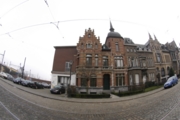Photographing long scenes with multi-viewpoint panoramas
Aseem Agarwala1 Maneesh Agrawala4 Michael Cohen3 David Salesin1,2 Rick Szeliski31University of Washington 2Adobe Systems 3Microsoft Research 4UC Berkeley


Abstract
We present a system for producing multi-viewpoint panoramas of long,
roughly planar scenes, such as the facades of buildings along a city
street, from a relatively sparse set of photographs captured with a
handheld still camera that is moved along the scene. Our work is a
significant departure from previous methods for creating
multi-viewpoint panoramas, which composite thin vertical strips from a
video sequence captured by a translating video camera, in that the
resulting panoramas are composed of relatively large regions of
ordinary perspective. In our system, the only user input required
beyond capturing the photographs themselves is to identify the
dominant plane of the photographed scene; our system then computes a
panorama automatically using Markov Random Field optimization. Users
may exert additional control over the appearance of the result by
drawing rough strokes that indicate various high-level goals. We
demonstrate the results of our system on several scenes, including
urban streets, a river bank, and a grocery store aisle.
Citation
Aseem Agarwala, Maneesh Agrawala, Michael Cohen, David Salesin, Richard Szeliski.
Photographing long scenes with multi-viewpoint panoramas.
ACM Transactions on Graphics (Proceedings of SIGGRAPH 2006), 2006.
Paper
SIGGRAPH 2006 pre-print (4MB PDF)
Results
For each result we show a movie clip of the source images and a thumbnail image that links to the full resolution result. When you view the full resolution image, your browser will likely scale it (poorly) to the width of the window. In Firefox, clicking on the scaled image will show it un-scaled. In Internet Explorer, hovering the mouse over the scaled image should give you a button in the lower-right to un-scale the image.
| Input photographs (video) | Multi-viewpoint panorama |
 |
 |
 |
 |
 |
 |
 |
 |
 |
 |
 |
 |